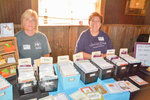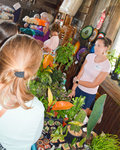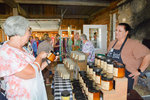After a two-year hiatus due to COVID-19, Gasconade County Soil and Water kicked off the 2022 OMG AgriPride Women in Ag event at the White Mule Winery on Sept. 8 with 221 women in attendance, …
This item is available in full to subscribers.
We have recently launched a new and improved website. To continue reading, you will need to either log into your subscriber account, or purchase a new subscription.
If you are a current print subscriber, you can set up a free website account by clicking here.
Otherwise, click here to view your options for subscribing.
Please log in to continue |
|





After a two-year hiatus due to COVID-19, Gasconade County Soil and Water kicked off the 2022 OMG AgriPride Women in Ag event at the White Mule Winery on Sept. 8 with 221 women in attendance, according to Diana Mayfield, district specialist 6 manager.
“I have heard nothing but good things,” Mayfield said Monday about the seventh annual event. “While 221 people came, there were 240 paid registrations and about 11 walk-ins.”
Three speakers were lined up for the evening to discuss entrepreneurship in agriculture, the alternative protein industry and how to create better grass rejuvenation by rotating fields and adding different grazing species to the cattle herds.
The evening’s keynote speaker was supposed to be Susie Thompson presenting Attitude Changes Everything. However, due to a family emergency, Thompson was forced to cancel the day before.
“Megan Rudroff from Rich Fountain in Osage County pulled her operation together within 24 hours to present,” Mayfield said, naming one of the Missouri Soil and Water’s own entrepreneurs. “Our prayers go out to Suzzie for her family emergency.”
Rudroff pulled together a presentation about how she created an alternative cash flow for her family’s ranch in the form of her business Rudy Lane Flower Farm.
The Rudroffs purchased a farm in their early 20s near Rich Fountain in Osage County.
“It was hard paying for a farm making minimum wage,” Runoff said.
However, she and her husband managed to rent the field out for cattle grazing while still having enough space to do their own thing.
“I wanted to do my own thing,” Rudroff said. “I thought about sheep and goats but with flowers maybe not goats. I also thought pasteurized poultry to eat bugs and make fertilizer but I have raccoons and skunks.”
Rudruff mentioned her farm came with several outbuildings “the way farms do.” She considered growing mushrooms, but the number of molds that mushrooms could encourage changed her mind.
“Then I came across a flower farm in Washington on Instagram,” she said. “90 percent of flowers are imported from overseas, so I clicked to see where the picture of the flower truck came from and it said a farm in Washington.”
This was something she could do. She purchased 175 bulb Peonies.
“I chose them because they have a short season,” said Rudroff, acknowledging the flower farm adds an additional cash crop to the family coffers. She now has 3,000 Peonie plants, but getting started in the middle of a pandemic was harrowing.
“I planted seven different varieties of Dahlias in 2020 to cash flow the peonies,” Rudroff said. “Then in 2020 everything closed during the wedding season. Then the Dahlias bloomed and I was too nervous to tell anyone. You eventually get over it and find yourself talking in front of a group of 240 people.”
As an alternative to in-person selling, she set up a driveway-side stand for fresh cut flowers, advertising social distance bouquets at the end of a country drive and used an honor system to collect payment.
“Now we are growing anything that compliments our bouquets,” Rudroff said. “Production is only 10 percent of the work. The rest is marketing.”
Rudroff began pushing her product by selling to local flower shops and advertising monthly flower subscriptions.
“If you are not going to market it, don’t do it,” Rudroff said.
Navigating the Alternative Protein Market by Dr. Bryon Wiegand
The first speaker of the day was Bryon Wiegand who opened with tips for Navigating the Alternative Protein Market. Wiegand said he is a meat scientist.
“Forty percent of food offered to Americans ends up in a landfill or as food waste,” Wiegand told the group. “This is not new. Plant-based protein is not new. What is new is the interest.”
Wiegand said technology is why interest has picked up in alternative meat sources. However, whole-food companies do not agree with each other’s opinions about plant-based proteins. The “Impossible Burger” has 19 ingredients; not all are necessarily considered healthy. He added that it is hard to make the argument that protein burgers are the more cost effective option.
“When the alternative protein sandwich called the ‘Impossible Burger’ first came out it was $1 more than the hamburger,” Wiegand said. “Now they are the same price.”
Wiegand said if the protein burgers were about getting more food to more people, it wouldn’t cost more to purchase. However, some meat companies are also jumping on board the protein wagon — sometimes for government subsidies or to seem more environmentally friendly.
“I tell my students if it is not immoral or illegal, we should probably do it,” Wiegand joked.
He speculated that some companies may jump in to cash in on the fad, only to cash out when the fad is over.
“More animals were sold to deep freezers during COVID than any other time in the world,” Wiegand. “Even though demand fell off the table (for protein burgers) while going through COVID.”
However, he says there is a space in the market for these products. The technology is becoming good enough that the taste of a meatball compared to a protein meatball is slight to none.
“I would be interested to know in 10 years if the market comes back and the demand for animal protein is strong or if people could be pushed out of the animal-based market by price,” Wiegand said.
On the economic side, at some point, the price will come back down.
“Currently a meatball grown in the lab is around $9,000, but it’s not going to stay there,” Wiegand said. “It is also susceptible to the same biohazards as animal-based proteins.”
Wiegand said animal-based protein is here for the long haul.
Adding Sheep and Goats to Your Cattle Herd by Dr. Bruce Shanks
Bruce Shanks spoke second during the event about the pros and cons of adding sheep and goats to cattle herds for grazing and encouraging grass rejuvenation.
“The biggest part of the room has cattle,” Shanks said after asking 220 people in the outdoor pavilion at the White Mule if they had goats or sheep and only six raised their hands for each herd. “The idea is about multi-species grazing. Right now we have a heavy emphasis on cows and some raising goats or sheep.”
He emphasized that all three species could be used to create multi-species grazing packages.
“Grazing can run sheep, goats, and cattle and it’s normal,” he began. “It’s normal to have diverse livestock.”
It is all about knowing and utilizing plants found in individual pastures.
“I know a lot of you guys are settling back and drinking your wine and can’t really concentrate,” Shanks said to laughter. “You have to understand pasture and land use.”
He asked the crowd to name several plants in a picture of his Osage County pasture, including ironweed and thistle.
“Sheep and goats don’t eat thistle well,” he said. “Blackberries and such are controlled by sheep or goats. Think about the things that aren’t a nuisance or that are a pest in our pastures.”
Cattle eat grass, goats browse, and sheep eat weeds and grass.
“The benefit to diversifying the herd is to improve pasture quality and increase capacity,” Shanks said. “Parasites are species-specific and cattle act as a parasite vacuum.”
Also, adding various species with different breeding and harvesting seasons allows for a better cash flow.
“Resources include an increased amount of ground while continuing to utilize the equipment already on hand as well as more fencing and animal health issues,” Shanks said.
An additional bonus is that the sheep and goat market has increased.
“Ultimately we are a grazing operation and we understand we are in the solar energy business,” Shanks said. “Apply grazing management by using fences and water and moving the animals as much as possible.”
The goal is always to leave residual grass in the ground to grow back and spread. If the rancher is successful, they will be able to continue the grazing rotation while saving funds on purchasing hay for as long as possible.
“Keep them out in the grazing rotation as much as possible,” Shanks suggested. “And the third tip is to work with mother nature.”
Shanks pointed out that under no circumstances do ranchers want their animals to grow too big or too fast or produce too much.
“Raise environmentally adapted animals, get rid of animals that aren’t working for you,” Shanks said. “Just make sure the enterprises complement one another.”
The speakers were broken up with breaks for supper and the opportunity to visit with area vendors. Items such as succulent plants, local honey, woven sheep wool clothing, furniture repair, sling purse designs, local sausage and more was available for sale.
“Last time we had the event, we had over 300 people,” Mayfield said. “We are pleased with the numbers and greatly appreciate the White Mule Winery hosting us and both doctors for moing and speaking at our event.